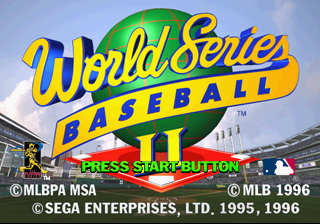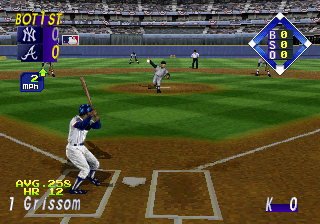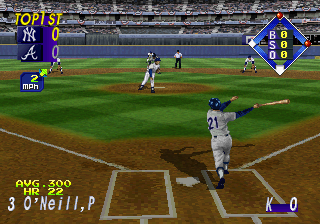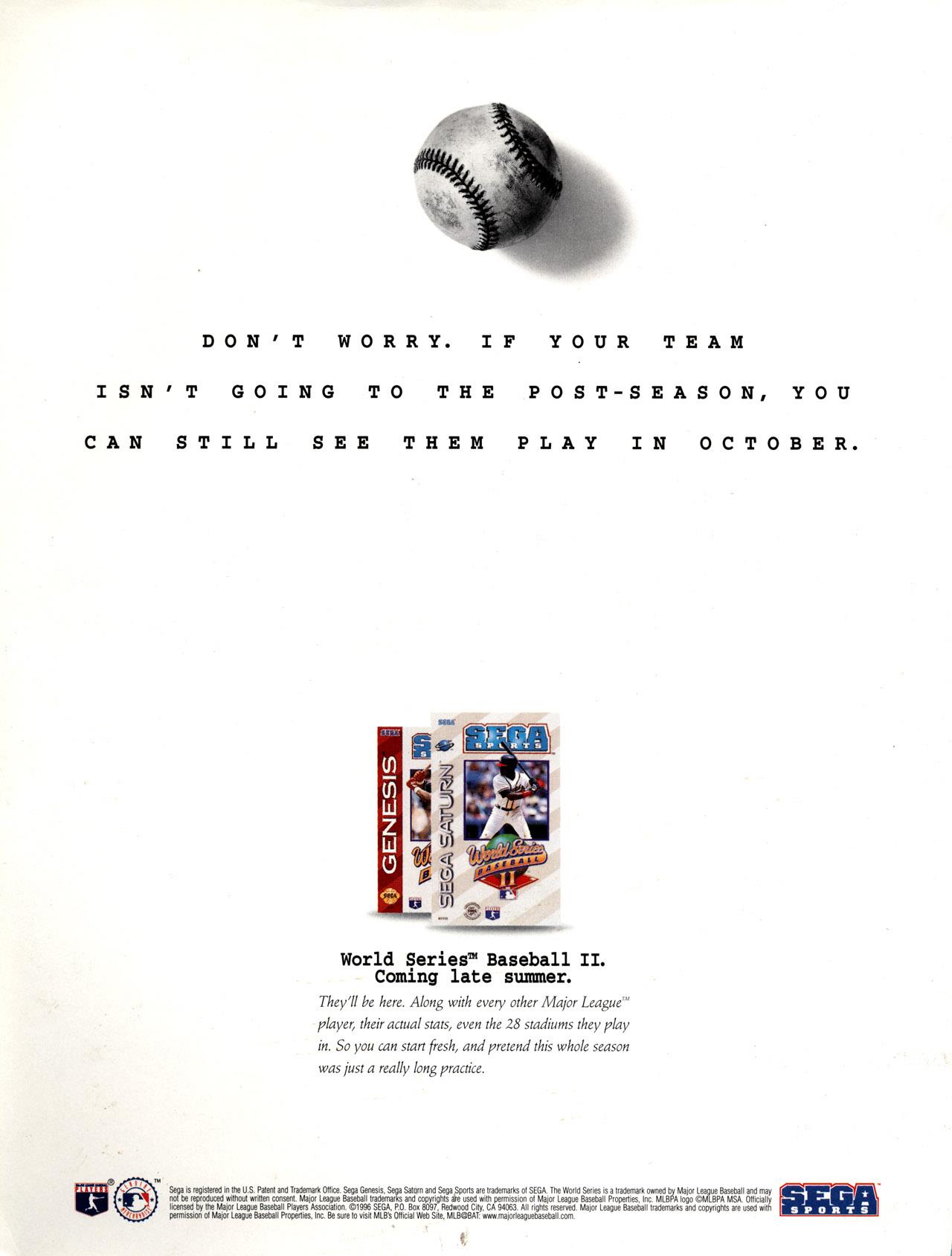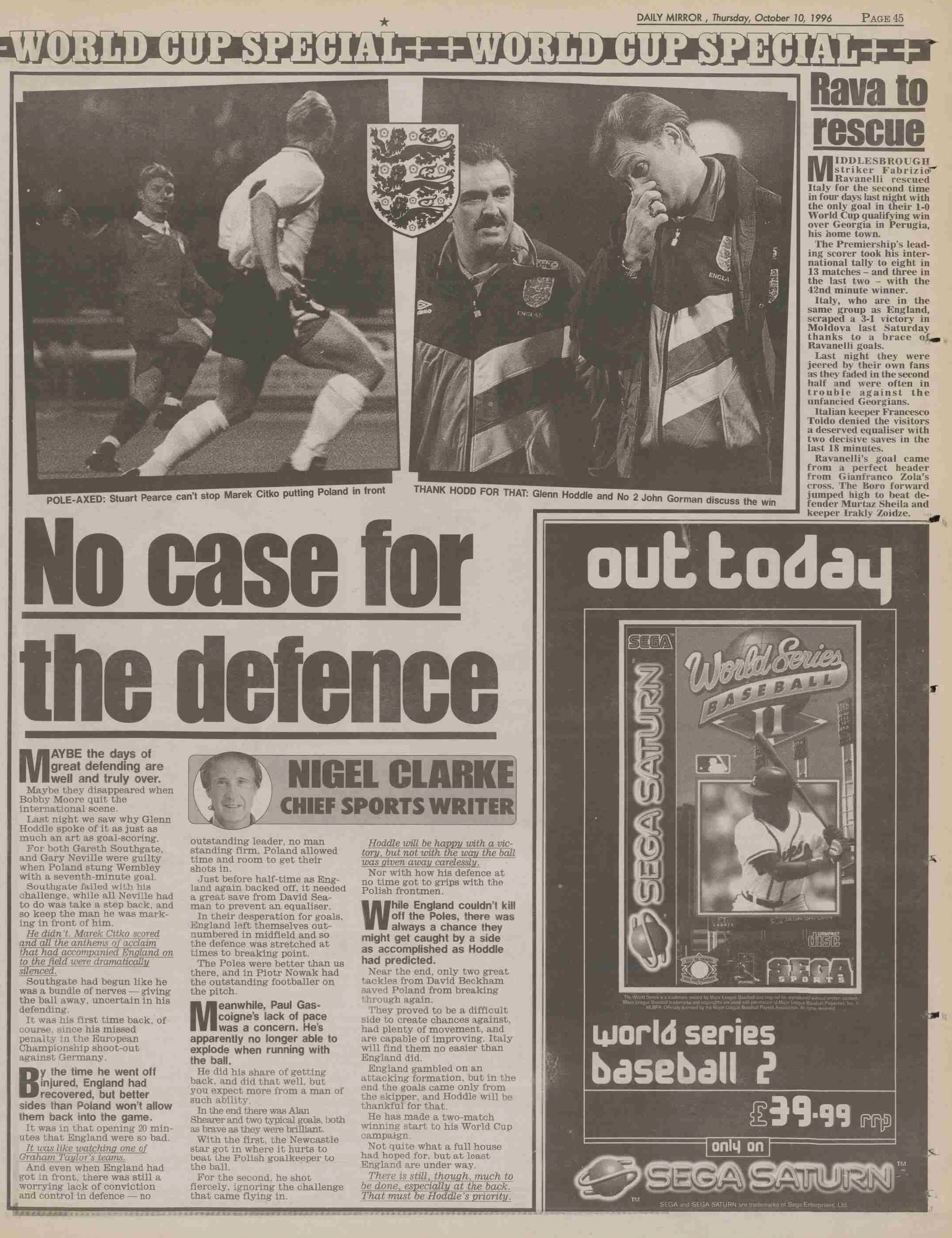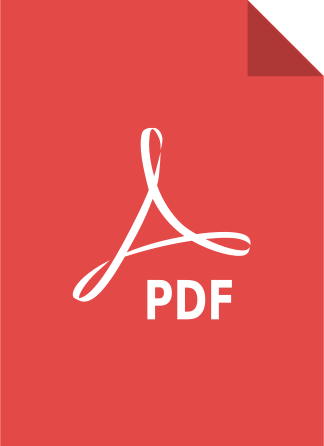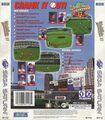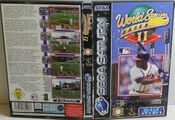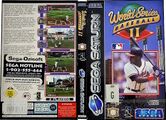World Series Baseball II
From Sega Retro
| World Series Baseball II | ||||||||||||||||||||||||||||||||||||||||
|---|---|---|---|---|---|---|---|---|---|---|---|---|---|---|---|---|---|---|---|---|---|---|---|---|---|---|---|---|---|---|---|---|---|---|---|---|---|---|---|---|
| System(s): Sega Saturn | ||||||||||||||||||||||||||||||||||||||||
| Publisher: Sega | ||||||||||||||||||||||||||||||||||||||||
| Developer: Sega | ||||||||||||||||||||||||||||||||||||||||
| Distributor: Sega-Ozisoft (AU) | ||||||||||||||||||||||||||||||||||||||||
| Licensor: Major League Baseball Properties, Major League Baseball Players Association | ||||||||||||||||||||||||||||||||||||||||
| Sound driver: SCSP/CD-DA (1 track) | ||||||||||||||||||||||||||||||||||||||||
| Peripherals supported: Saturn Backup Memory | ||||||||||||||||||||||||||||||||||||||||
| Genre: Sports[1][2] (baseball) | ||||||||||||||||||||||||||||||||||||||||
| Number of players: 1-2 | ||||||||||||||||||||||||||||||||||||||||
|
World Series Baseball II (ワールドシリーズベースボールⅡ) is a Sega Saturn baseball game developed and published by Sega. An entry in the World Series Baseball series of baseball titles, it is a version of Greatest Nine '96 with Major League Baseball players, teams, and ballparks. The game was first released in the United States in August 1996, and was later brought to Japan, Europe, and Australia in the following months.
The game is a sequel to the 1995 Sega Saturn baseball title World Series Baseball, and it was followed by World Series Baseball 98 in 1997.
Contents
Gameplay
The game plays identically to its predecessor but with several additions. Players can choose from any of the 28 teams from the 1996 MLB season. All 28 team stadiums have been recreated for the game. The 1998 expansion teams, the Arizona Diamondbacks and the Tampa Bay Devil Rays, are also present. However, since they had not yet played a game at the time of the release, they have not been assigned divisions or rosters and do not have ballparks. Instead, for each expansion team, the player must create a custom roster and replace an existing team in a division (adopting that team's ballpark). The game also adds new music, sound effects, and commentary, more player animations, and additional camera angles (including angles from the point of view of the outfielders). The angle for the pitching and batting view is now slightly off-center (pivoting depending on whether the batter is left- or right-handed).
The game retains the modes from its predecessor:
- Exhibition Mode: An exhibition mode, for playing a single game against a human or computer player. The player can also watch two computer-controlled teams play. The player chooses the team and the batting line-up for computer players.
- Pennant Race: Plays a season of 13, 26, or a full 162 games, culminating in the World Series. The game uses the Saturn's internal memory or a backup cartridge to save the player's progress.
- Playoffs: A truncated season with only the play-offs. Up to four players can participate, with two players playing at a time.
- All-Star Game: An exhibition mode against a human or computer player but featuring teams consisting of the best players from the American and National Leagues.
- Home Run Derby: A competition where players can choose any player in the league and compete to get the most home runs. There are no balls, strikes, or outs and no baserunning or fielding. This mode can be played with up to four players taking turns (with the computer pitching for every player), with each player batting for 5, 10, 15, or 20 balls.
- Data Base: View the statistics for any of the 700 players in the game.
Before each game, players choose a team and a batting line-up. Players can choose from any of the 28 major league ballparks, set the number of innings, toggle designated hitters (whether the pitcher bats or a designated hitter replaces him in the batting line-up), toggle errors (whether fielders occasionally drop fly balls or miss grounders), and toggle wind and weather (whether wind conditions affect the ball physics). When playing against a computer-controlled opponent, the player also sets the difficulty level (Rookie, Veteran, All-Star, or Legend).
Teams
| League | Division | Team | Stadium |
|---|---|---|---|
| American | Western | California Angels | Anaheim Stadium |
| Oakland Athletics | Oakland Coliseum | ||
| Seattle Mariners | Kingdome | ||
| Texas Rangers | The Ballpark | ||
| Central | Chicago White Sox | Comiskey Park | |
| Cleveland Indians | Jacobs Field | ||
| Kansas City Royals | Kauffman Stadium | ||
| Milwaukee Brewers | County Stadium | ||
| Minnesota Twins | Metrodome | ||
| Eastern | Baltimore Orioles | Camden Yards | |
| Boston Red Sox | Fenway Park | ||
| Detroit Tigers | Tiger Stadium | ||
| New York Yankees | Yankee Stadium | ||
| Toronto Blue Jays | SkyDome | ||
| National | Western | Colorado Rockies | Coors Field |
| Los Angeles Dodgers | Dodger Stadium | ||
| San Diego Padres | Jack Murphy Stadium | ||
| San Francisco Giants | 3Com Park | ||
| Central | Chicago Cubs | Wrigley Field | |
| Cincinnati Reds | Riverfront Stadium | ||
| Houston Astros | Astrodome | ||
| Pittsburgh Pirates | Three Rivers Stadium | ||
| St. Louis Cardinals | Busch Stadium | ||
| Eastern | Atlanta Braves | Fulton County Stadium | |
| Florida Marlins | Joe Robbie Stadium | ||
| Montreal Expos | Olympic Stadium | ||
| New York Mets | Shea Stadium | ||
| Philadelphia Phillies | Veterans Stadium | ||
| Expansion | Unassigned | Arizona Diamondbacks | — |
| Tampa Bay Devil Rays | — |
Production credits
- Main article: World Series Baseball II/Production credits.
Magazine articles
- Main article: World Series Baseball II/Magazine articles.
Promotional material
also published in:
- Next Generation (US) #22: "October 1996" (1996-09-17)[11]
- Electronic Gaming Monthly (US) #87: "October 1996" (1996-xx-xx)[12]
Physical scans
| Sega Retro Average | |||||||||||||||||||||||||||||||||||||||||||||||||||||||||||||||||||||||||||||||||||||||||||||||||||||||||||||||||||||||
|---|---|---|---|---|---|---|---|---|---|---|---|---|---|---|---|---|---|---|---|---|---|---|---|---|---|---|---|---|---|---|---|---|---|---|---|---|---|---|---|---|---|---|---|---|---|---|---|---|---|---|---|---|---|---|---|---|---|---|---|---|---|---|---|---|---|---|---|---|---|---|---|---|---|---|---|---|---|---|---|---|---|---|---|---|---|---|---|---|---|---|---|---|---|---|---|---|---|---|---|---|---|---|---|---|---|---|---|---|---|---|---|---|---|---|---|---|---|---|---|
|
| 78 | |
|---|---|
| Based on 23 reviews | |
Technical information
- Main article: World Series Baseball II/Technical information.
External links
- Sega of America webpage: Saturn
References
- ↑ File:WSBII Saturn JP Box Back.jpg
- ↑ 2.0 2.1 https://sega.jp/history/hard/segasaturn/software.html (Wayback Machine: 2020-03-30 22:53)
- ↑ http://www.sega-saturn.com/saturn/other/august-n.htm (Wayback Machine: 2016-05-12 16:03)
- ↑ https://groups.google.com/g/rec.games.video.sega/c/dGxs59GNrlw/m/ODQe_TSeHU0J
- ↑ https://groups.google.com/g/rec.games.video.sega/c/crUnq9iyLzg/m/hkwwPRs3CBsJ
- ↑ Press release: 1996-05-16: ALL-STAR LINE-UP OF SEGA SPORTS VIDEOGAMES EXPANDS THE PROVEN TOP-SELLING FRANCHISE
- ↑ File:DailyMirror UK 1996-10-10 45.png
- ↑ Computer Trade Weekly, "" (UK; 1996-10-07), page 24
- ↑ 9.0 9.1 Computer & Video Games, "December 1996" (UK; 1996-11-xx), page 90
- ↑ Sega Magazin, "November 1996" (DE; 1996-10-09), page 71
- ↑ Next Generation, "October 1996" (US; 1996-09-17), page 115
- ↑ Electronic Gaming Monthly, "October 1996" (US; 1996-xx-xx), page 167
- ↑ CD Consoles, "Janvier 1997" (FR; 199x-xx-xx), page 116
- ↑ Famitsu, "1996-11-01" (JP; 1996-10-18), page 1
- ↑ Fun Generation, "12/96" (DE; 1996-11-13), page 99
- ↑ GamePro, "November 1996" (US; 1996-xx-xx), page 145
- ↑ Game Informer, "October 1996" (US; 1996-xx-xx), page 47
- ↑ Joypad, "Novembre 1996" (FR; 1996-1x-xx), page 80
- ↑ MAN!AC, "11/96" (DE; 1996-10-09), page 85
- ↑ Mega Force, "Novembre/Décembre 1996" (FR; 1996-1x-xx), page 70
- ↑ Mega Fun, "10/96" (DE; 1996-09-18), page 66
- ↑ Mean Machines Sega, "November 1996" (UK; 1996-10-04), page 72
- ↑ Next Generation, "December 1996" (US; 1996-11-19), page 266
- ↑ Player One, "Décembre 1996" (FR; 1996-xx-xx), page 136
- ↑ Saturn Fan, "1996 No. 22" (JP; 1996-10-18), page 192
- ↑ Saturn Fan, "1996 No. 25" (JP; 1996-11-29), page 70
- ↑ Saturn+, "Issue 4" (UK; 1996-10-24), page 31
- ↑ Sega Power, "December 1996" (UK; 1996-10-24), page 58
- ↑ Sega Saturn Magazine, "November 1996" (UK; 1996-10-17), page 68
- ↑ Sega Saturn Magazine, "1996-18 (1996-10-25)" (JP; 1996-10-11), page 225
- ↑ Sega Saturn Magazine, "Readers rating final data" (JP; 2000-03), page 12
- ↑ Total Saturn, "Volume One Issue Two" (UK; 1996-09-30), page 60
- ↑ Total Saturn, "Volume One Issue Four" (UK; 1996-12-29), page 67
- ↑ Ultra Game Players, "November 1996" (US; 1996-10-08), page 129
| World Series Baseball II | |
|---|---|
|
Main page | Credits | Hidden content | Development | Magazine articles | Reception | Technical information | |
| Games in the World Series Baseball Series | |
|---|---|
| World Series Baseball (1994) | World Series Baseball '95 (1995) | World Series Baseball '96 (1996) | World Series Baseball 98 (1997) | |
| World Series Baseball (1993) | World Series Baseball '95 (1994) | Nomo's World Series Baseball (1995) | |
| World Series Baseball Starring Deion Sanders (1995) | |
| World Series Baseball (1995) | World Series Baseball II (1996) | World Series Baseball 98 (1997) | |
| World Series Baseball '96 (1996) | |
| World Series 99 (1999) | World Series Baseball (2001) | |
| World Series Baseball 2K1 (2000) | World Series Baseball 2K2 (2001) | |
| World Series Baseball (2002) | World Series Baseball 2K3 (2003) | |
| World Series Baseball related media | |
| Prima's Official Strategy Guide: World Series Baseball 2K1 (2000) | |
- Saturn Backup Memory-compatible games
- 1-2 player games
- JP Saturn games
- All JP games
- US Saturn games
- All US games
- EU Saturn games
- All EU games
- DE Saturn games
- All DE games
- UK Saturn games
- All UK games
- PL Saturn games
- All PL games
- AU Saturn games
- All AU games
- Saturn games
- 1996 Saturn games
- All 1996 games
- Saturn baseball games
- Saturn sports games
- All sports games
- Saturn games with Cinepak video
- Saturn games using CyberSound
- All games
- World Series Baseball II
- World Series Baseball (franchise)
